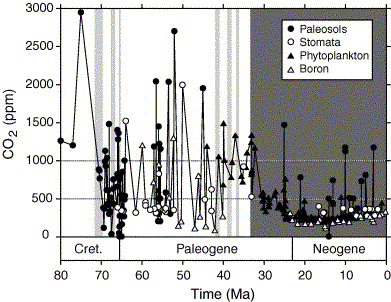
Fig. 1. Atmospheric CO2 through the Phanerozoic. (A) Temporal distribution of the CO2 proxy record, expressed in 10 my time blocks. (B) Phanerozoic CO2 proxy record, categorized by method. Errors in CO2 estimates and ages are given when available. See electronic annex for further details. (C) The same CO2 record as in (B), but expressed as a time series without error bars. Also plotted are the range of reasonable CO2 predictions from the geochemical model GEOCARB III (Berner and Kothavala, 2001). (D) Comparison of the best-guess predictions of GEOCARB III (dashed line) with a smoothed representation of the proxy record (solid line; locally weighted regression [LOESS]; sampling proportion = 0.1; polynomial degree = 2) that best matches the temporal resolution of GEOCARB (〜10 my time-step). This approach differs from Royer et al. (2004), who expressed the proxy record in 10 my time-steps, because here the ages of the GEOCARB output have been calibrated to the timescale of Gradstein et al. (2004) and no longer follow an even 10 my time-step.

Fig. 4. CO2 and temperature records for the late Cretaceous to present day (80-0 Ma). The CO2 record is derived from Fig. 1B. Cold periods with strong evidence for geographically widespread ice are marked with dark shaded bands. Cool-to-cold periods with indirect or equivocal evidence for ice (see Section 2 for details) are marked with light shaded bands; such periods supported by only weak evidence are annotated with a question mark. The horizontal dashed lines at 1000 and 500 ppm CO2 represent the proposed CO2 thresholds for, respectively, the initiation of globally cool events and full glacials.
〔Royer,D.L.(2006): CO2-forced climate thresholds during the Phanerozoic. Geochimica et Cosmochimica Acta, 70, 5665-5675.から〕